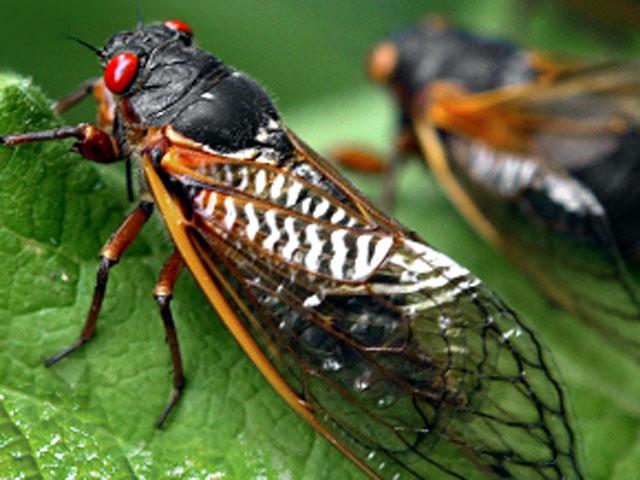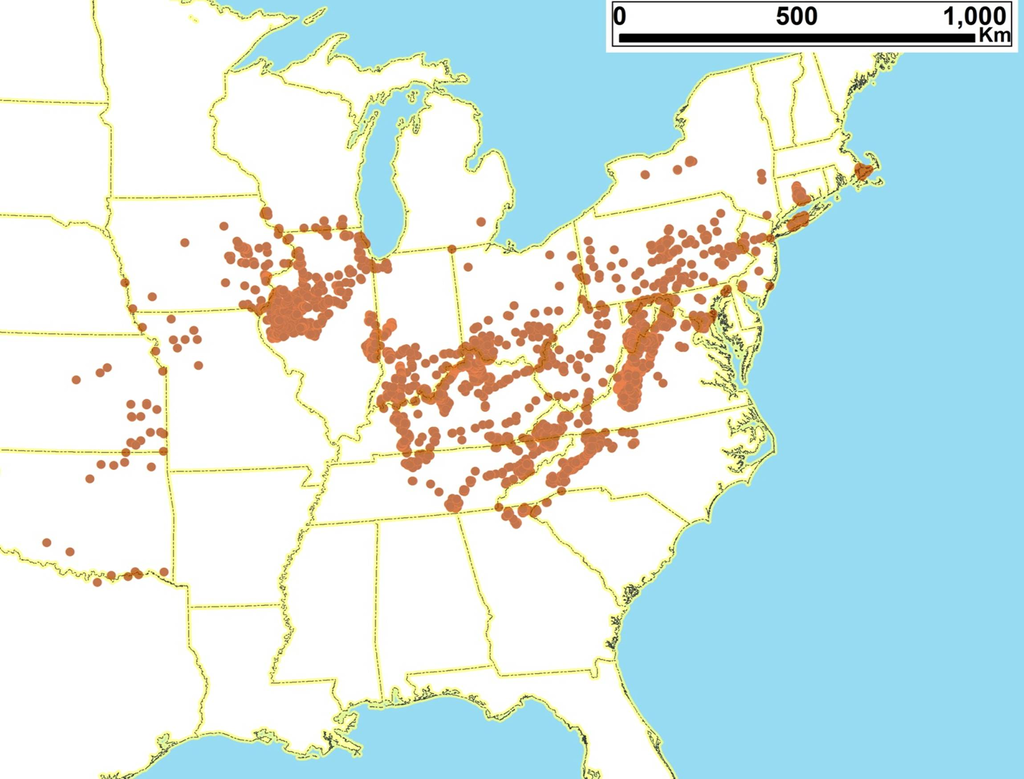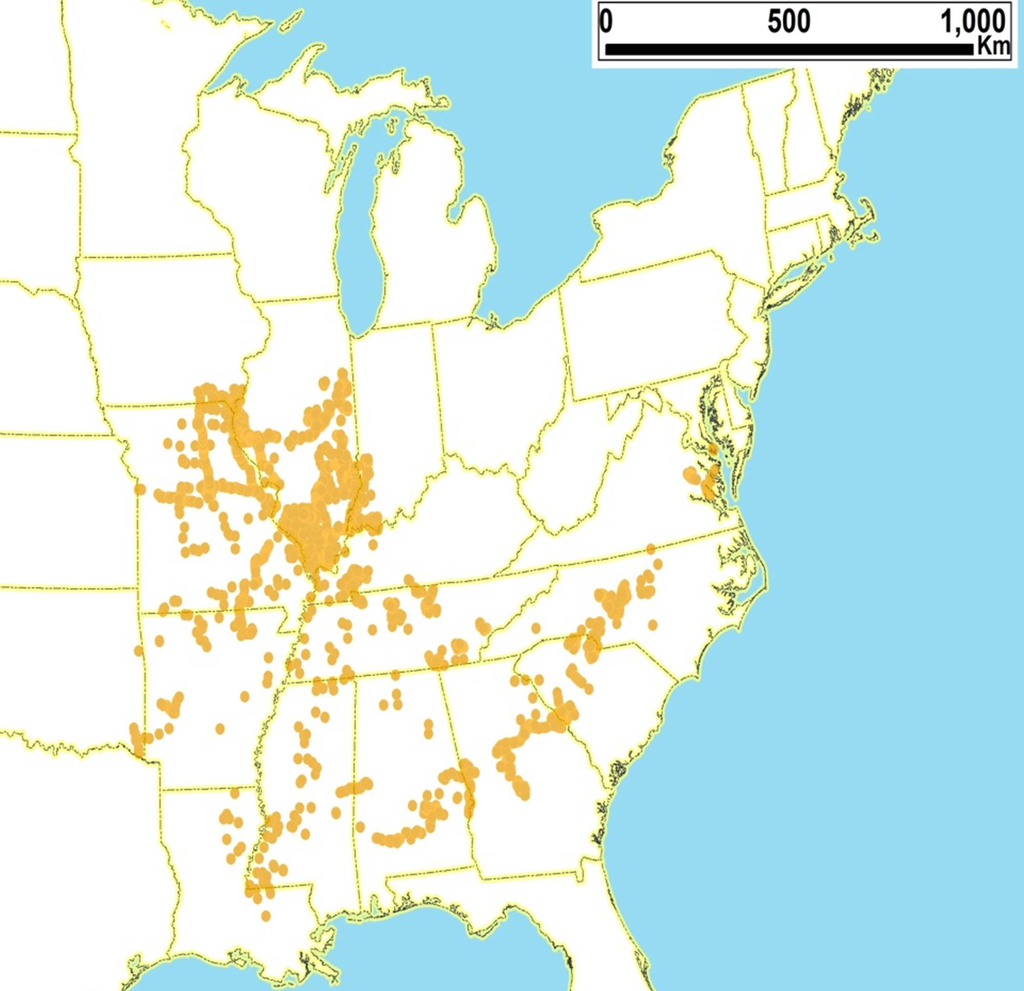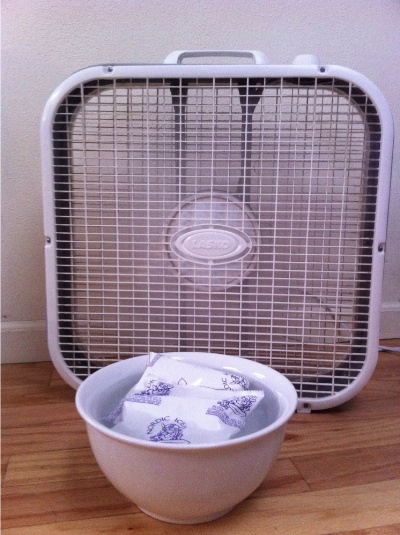The air is buzzing with the noise of cicadas. Which makes me realize, I know next to nothing about them. I'm not a fan of their appearance, but I'm very curious about the loud noise they make. So what's the deal with cicada sounds?

The Magicicada septendecim emerges every 17 years.
(Photo from Crockett Facilities Services)

Close-up of one tymbal relaxed, then contracted. Popping the tymbal in and out makes a popping noise.
(Diagram from The Robinson Library)

Cross-sections of a cicada's abdomen. You can see the largely empty abdomen and how much space there is for the noise of the tymbal to create an echo.
(Diagram from The Robinson Library)

Distribution map of the 17-year Magicicada species populations.

Distribution map of the 13-year Magicicada populations.
(Map from Sanborn & Phillips, Biogeography of the Cicadas, Diversity 2013)

The life cycle of a cicada
(Diagram from The HouseholdPests.org)
Sources
Cicada Mania
The Robinson Library, Family Cicadidae
Howstuffworks, How Cicadas Work
Colorado State University Extension, Cicadas
National Geographic, Cicada
Science Daily, Secrets of the Cicada's Sound, May 30, 2013

The Magicicada septendecim emerges every 17 years.
(Photo from Crockett Facilities Services)
- There are about 3,400 species of cicada in the world, and over 190 species and sub-species in North America alone. So talking about cicadas in general means you're generalizing about a lot of different species, each with slightly different characteristics. But generalizing is what I'm going to do anyway.
- In most cicada species, it's the males who make the noise, and the noise they're making is a mating song.
- Females make their own sound by flicking their wings, which sounds similar to a light switch being flipped on and off. In some species, females make this sound in response to the males' mating song.
- Cicadas make other sounds too, such as distress alarms when a predator is attacking, or warm-up calls before the males launch into their big production. But we have a harder time hearing those other calls and distinguishing them from each other. So most of the time when people are talking about cicada noises, they mean the loud mating call of the males.
- If you think it sounds like thousands of cicadas are making the same noise together, you're not wrong. Males will synchronize their songs with each other so they are all going off at the same time. This establishes a "chorusing center" and works to attract large numbers of females to the same place, increasing everybody's odds of finding a mate.
- Exactly how each cicada makes his song isn't entirely understood. What we do know is that each cicada has two bumps on either side of their abdomen. The bumps are called tymbals. Special muscles inside the abdomen make the tymbals contract and make a popping noise, and then the muscles pop the tymbals back out again to make another popping noise.

Close-up of one tymbal relaxed, then contracted. Popping the tymbal in and out makes a popping noise.
(Diagram from The Robinson Library)
- They work a lot like those metal clicker toys you may have played with when you were a kid, popping the metal up and down to make a clicking sound.
- The difference is a male cicada can make those tymbals pop in and out 100 to 500 times per second.
- The other difference is the echo. The tymbals are housed in the cicada's exoskeleton. Beneath the tymbals, the body of the abdomen is mostly hollow. So the clicking of the tymbals at rapid-fire speed gets echoed again and again, and the echoes echo each other.

Cross-sections of a cicada's abdomen. You can see the largely empty abdomen and how much space there is for the noise of the tymbal to create an echo.
(Diagram from The Robinson Library)
- Making the tymbals pop in and out would be, for us, like making our entire rib cage collapse and expand over and over again 100 to 500 times a second.
- But on the cicada, it looks like it's shaking its tail like a rattlesnake.
- Knowing this much about how the process works, you would think scientists would be able to replicate the sound. Nope.
- Naval researchers have tried for years to figure out how to do what the cicada does, in order to create a very loud sound that will travel a long way through water, produced using very little power. "We're still working on it," researchers say.
- Perhaps the most mysterious part of the process is exactly why it's so loud. But it definitely is loud -- deafening, in fact.
- One species of cicada in Australia is said to produce a call that exceeds 120 decibels at close range. At this level, sounds reach the deafening point. Other things that hit 120 decibels: fireworks displays at close range. Thunder. A passing freight train -- louder even than that.
- The loudest cicada in North America was recorded by the University of Florida at 108.9 decibels. This is just slightly less loud than that passing freight train.
- The video below is of this species of cicada, the Neotibicen pronotalis walkeri (formerly Tibicen pronotalis walkeri), or the Walker's Cicada. It lives in 28 of the 50 states, mainly in the Midwest and the South.
- Even the cicadas have to protect themselves from their own noisy mating songs. On either side of their head, both males and females have large membranes called tympana. Yup, they're like ears. A short tendon connects each tympana to the auditory organ in the cicada's head. When the male sings, that tendon retracts, pulling the middle of the tympana inward, creasing it so that it will not absorb his own sound.
- In a manner of speaking, he's putting ear plugs in to protect himself from the decibels of his own song. (Pete Townshed, eat your heart out?)
- The males also tone it down a bit when an interested female approaches.
Life Cycles and Brood Cycles
- The female lays her eggs in the roots or branches of a tree. After the eggs hatch, the young cicadas are pale little worm-like things. They live underground, in the tree roots, drinking the tree's xylem (nutritional fluids). They are too small to damage the trees they live on, even in high numbers.
- In some species, the young stay down there for two or three years before they crawl up to the surface, shedding their nymph exoskeleton on the way, to begin their life as an adult. In other species, the young may stay underground as long as 17 years.
- Still other species emerge each year, but every several years, enormous numbers of them will surface at once.
- Once the adults are above ground with their new skin, wings inflated and ready to go, they fly up into the trees where the males start their songs and the females commence their clicking.
- One genus, the Magicicada, has species such as the septendecim that emerge every 17 years (Latin lovers will notice the word for "seventeen" in the name) or 13 years.
- There are pockets of Magicicada in various places around the U.S. One pocket, or brood, emerged this year in Iowa, Kansas, Missouri, Nebraska, Oklahoma, and Texas. In 2016, another 17-year brood is due to emerge in New York, Ohio, Pennsylvania, Virginia, and West Virginia. (To see a chart of brood cycles across the country, check out Cicada Mania)
- The fact that this species has broods across several states that each emerge at different times, plus the fact that there are many other species that emerge annually or close to that is why it seems like there are a ton of cicadas in some part of the country each year.

Distribution map of the 17-year Magicicada species populations.

Distribution map of the 13-year Magicicada populations.
(Map from Sanborn & Phillips, Biogeography of the Cicadas, Diversity 2013)
- As adults, cicadas live only about 4 to 6 weeks before they die.

The life cycle of a cicada
(Diagram from The HouseholdPests.org)
Cicadas Are Not Locusts
- It is important to note that cicadas are not locusts, which are migratory grasshoppers. It is tempting to think there's a plague of cicadas when you see them in enormous numbers singing their crazy loud songs to each other. But that is simply not true.
- Cicadas do very little damage to the trees they live on, either as adults that we can hear and see all over the place, or as nymphs underground. Some younger trees might struggle with the effects of large numbers of cicadas, but older trees do just fine.
- They don't bite or sting people. They're not interested in people at all. They just want to get it on, give up the ghost, and that's it.
Bonus Fact
- Small cicadas make their songs at a pitch higher than what humans can hear. But dogs and other animals can hear them, and if they're close enough, the high-pitched song can be loud enough to make the dog wince or whine in pain.
Sources
Cicada Mania
The Robinson Library, Family Cicadidae
Howstuffworks, How Cicadas Work
Colorado State University Extension, Cicadas
National Geographic, Cicada
Science Daily, Secrets of the Cicada's Sound, May 30, 2013









